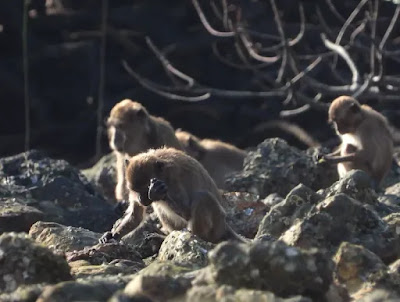Yale Prof. Jessica Thompson; Shots: Health News: Nell Greenfieldboyce, All Things Considered, NPR.org, March 10, 2023; CC Liu, Sheldon S., Ashley Wells (eds.), Wisdom Quarterly
 |
| Would sliced bananas taste better? |
Stone flakes made by modern monkeys trigger big questions about early humans
When monkeys in [devoutly Theravada Buddhist] Thailand use stones as hammers and anvils to help them crack open nuts, they often accidentally create sharp flakes of rock that look like the stone cutting tools made by early humans.
[One smart monkey has not yet been spotted cutting anything with one of these stone knives, but when one is, what then? So much for human supremacy. Due to the phenomenon known as the hundredth monkey effect, as soon as one does, another will see it and copy it, then another, then when 100 do, all of them will without having seen any other monkey do it. They'll be making and using them thus hastening their evolution through a process described in anthropology as punctuated equilibrium (socially). These monkeys are already at the "human" stage of Homo habilis (shown here).]
Homo habilis, half-monkey/half-human?
This surprising discovery, described in the journal Science Advances, has archeologists wondering if they need to rethink their assumptions about some of the stone artifacts produced by early human ancestors over a million years ago.
 |
| Yale Prof. J. Thompson studies evolution |
[She's] a paleoanthropologist with Yale University who wasn't on the team that did this new research [but who studies these sorts of things and human evolution].
 |
| This monkey took this selfie using a hi-tech tool. |
She notes that the manufacture of sharp cutting tools made of stone, which could date as far back to 3.3 million years ago, has long been seen as a key technological innovation in human history.
[It's] one that's wrapped up in a host of assumptions about the evolution of unique human traits.
But now, says Prof. Thompson, archeologists will have to grapple with the problem of trying to figure out whether sharp stone flakes were made intentionally or accidentally. More + VIDEO
Yeah, but can monkeys make and use fire?
Prof. J. Thompson explains how fire may almost make humans unique.





















































































































































































































































No comments:
Post a Comment